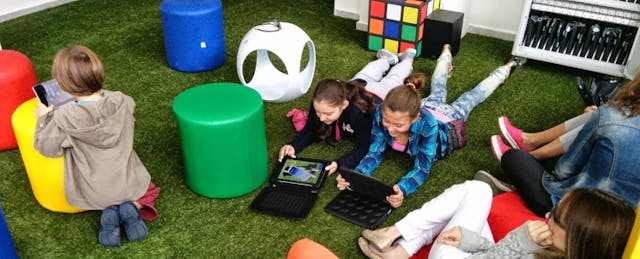Porvir reporter, Fernanda Kalena contributed to this report.
What if we could adapt Google’s colorful and playful work environment--consistently ranked as one of the top places to work--into a school to improve the learning experience?
In Brazil, the search giant recently launched the Google Learning Space, a lab with Google-like furniture and technologies, at Mater Dei, a private school in São Paulo. The announcement of was made during Educar Educador, the annual Brazilian education conference attended by over 20,000 educators this year.
Instead of an ordinary classroom with neat rows of desks and chairs in front of a blackboard, the Learning Space has seating cubes, cushions and a grass-like carpet that encourages students to sit on the floor. The furniture can easily be rearranged to fit whatever setup a class may need. Complementing this are Google technologies like Chromecasts, SmartTVs, a sound system and a high-performance wireless network.
The open space is designed to foster an environment of collaboration, says Milton Burgese, head of Google Education in Brazil. Teachers can mediate a variety of learning activities, from individual studies to group projects using Google Drive. “The way this classroom is organized enables interaction among students in the real and virtual world, in the same way Google apps do. Students now are closer, collaborating and creating,” he says.
The decision to build a Google Learning Space came as a result of a partnership between the search giant and ForEducation, a startup founded by Eduardo Gomide that specializes in teachers development. His team was in charge of training educators to use Google apps, while the Google team shared its expertise in how to organize a physical space in order to support a more open learning environment.
At 35 square meters, the Google Learning Space can comfortably hold a classroom of 30 students. At Mater Dei, which houses 450 students from pre-K to high school, classes take turns using the space for all kinds of activities. Teachers can schedule a time, but availability may be hard to come by. Gomide says the space is being used “100% of the time.”
This is a rough breakdown of how the room is currently being used, according to Gomide. (Blue: pre-K; red: grades 1-5; yellow: grades 6-9; green: high school.)

Both parties say they have noticed a cultural shift in the teachers’ and students’ attitude toward the use of technology in the classroom. “We saw increased engagement among all--from the principal to the students--and a wiliness to use technology in class,” says Burgese.
“Students understood and valued our proposal. Kids began to ask for more than just using Google Apps. They wanted a space of experimentation where they could have a more horizontal exchange of knowledge, a place where they could breathe that new culture and expand their use of technology,” he continued.
The mix of colorful furniture and new technology is certainly attractive, and many schools are interested in creating this kind of space, says Gomide. But he stresses that in order to put this environment to its best use, it is equally--if not more--important to prepare educators to rethink the traditional model of learning. "The physical environment is very easy to build. The hardest part was making a cultural change, convincing teachers to change their attitude and starting using technology," he says. "Over time, we will need to have more of these classrooms. Our vision is that all classrooms will be remodeled to be closer to that space”, the entrepreneur adds.
Google intends to use this pilot as a model for similar learning spaces in other countries. But Burgese says schools must be open to changing up their traditional methods of delivery education before any of the pretty physical objects are put in place. "This is not a McDonald's franchise. There's a lot that needs to be done before having a space like this. There is no reason to have a super cool classroom if no one knows how to use it", he explains.


